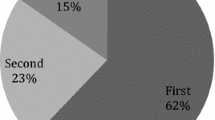Abstract
Measuring scientific performance is currently a common practice of funding agencies, fellowship evaluations and hiring institutions. However, as has already been recognized by many authors, comparing the performance in different scientific fields is a difficult task due to the different publication and citation patterns observed in each field. In this article, we defend that scientific performance of an individual scientist, laboratory or institution should be analysed within the corresponding context and we provide objective tools to perform this kind of comparative analysis. The usage of the new tools is illustrated by using two control groups, to which several performance measurements are referred: one group being the Physics and Chemistry Nobel laureates from 2007 to 2012, the other group consisting of a list of outstanding scientists affiliated to two different institutions.
Similar content being viewed by others
References
Alonso, S., Cabrerizo, F. J., Herrera-Viedma, E., & Herrera, F. (2009). h-Index: A review focused in its variants, computation and standardization for different scientific fields. Journal of Informetrics, 3(4), 273–289.
Bornmann, L., Mutz, R., & Daniel, H. D. (2008). Are there better indices for evaluation purposes than the h index?A comparison of nine different variants of the h index using data from biomedicine. Journal of the American Society for Information Science and Technology, 59, 830–837.
Coleman, B. J., Bolumole, Y. A., & Frankel, R. (2012). Benchmarking individual publication productivity in logistics. Transportation Journal, 51(2), 164–196.
El Emam, K., Arbuckle, L., Jonker, E., & Anderson, K. (2012). Two h-index benchmarks for evaluating the publication performance of medical informatics researchers. Journal of Medical Internet Research, 14(5). doi: 10.2196/jmir.2177.
Geoffrion, A. M., Dyer, J. S., & Feinberg, A. (1972). An interactive approach for multi-criterion optimization, with an application to the operation of an academic department. Management Science, 19, 357–368.
Glänzel, W. (2006). On the Opportunities and Limitations of the H-index. Science Focus, 1(1), 10–11.
Harzing, A. (2010). The publish or perish book. Melbourne, Australia: Tarma Software Research.
Hirsch, J. E. (2005). An index to quantify an individual’s scientific research output. Proceedings of the National Academy of Sciences of the United States of America, 102, 16569–16580.
Iglesias, J. E., & Pecharromán, C. (2007). Scaling the h-index for different scientific ISI fields. Scientometrics, 73(3), 303–320.
Imperial, J., & Rodríguez-Navarro, A. (2007). Usefulness of Hirsch’s h-index to evaluate scientific research in Spain. Scientometrics, 71(2), 271–282.
Köksalan, M. M., & Sagala, P. N. S. (1995). Interactive approaches for discrete alternative multiple criteria decision making with monotone utility functions. Management Science, 41, 1158–1171.
Lehmann, S., Jackson, A. D., & Lautrup, B. E. (2008). A quantitative analysis of indicators of scientific performance. Scientometrics, 76, 369–390.
Lundberg, J. (2007). Lifting the crown-citation z-score. Journal of Informetrics, 1, 145–154.
Moed, H. F., Debrun R. E., & Vanlleuwen T. (1995). New bibliometric tools for the assessment of national research performance-database description, overview of indicators and first applications. Scientometrics, 33, 381–422.
Moed, H. F. (2009). New developments in the use of citation analysis in research evaluation. Archivum immunologiae et therapiae experimentalis, 57(1), 13–18.
Panaretos, J., & Malesios, C. (2009). Assessing scientific research performance and impact with single indices. Scientometrics, 81(3), 635–670.
Podlubny, I. (2005). Comparison of scientific impact expressed by the number of citations in different fields of science. Scientometrics, 64(1), 95–99.
Radicchi, F., Fortunato, S., & Castellano, C. (2008). Universality of citation distributions: Toward an objective measure of scientific impact. Proceedings of the National Academy of Sciences of the United States of America, 45, 17268–17272.
Saaty, T. (1988). What is the Analytic hierarchy process? Mathematical models for Decision Support, 48, 109–121.
Schulze, M. (2003). A new monotonic and clone-independent single winner election method. Voting Matters, 17, 9–19.
Tideman, T. N. (1987). Independence of clones as a criterion for voting rules. Social Choice and Welfare, 4, 185–206.
Author information
Authors and Affiliations
Corresponding author
Rights and permissions
About this article
Cite this article
Sorzano, C.O.S., Vargas, J., Caffarena-Fernández, G. et al. Comparing scientific performance among equals. Scientometrics 101, 1731–1745 (2014). https://doi.org/10.1007/s11192-014-1368-6
Received:
Published:
Issue Date:
DOI: https://doi.org/10.1007/s11192-014-1368-6




